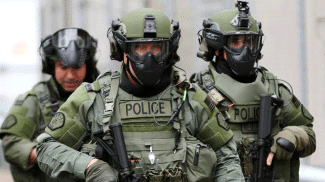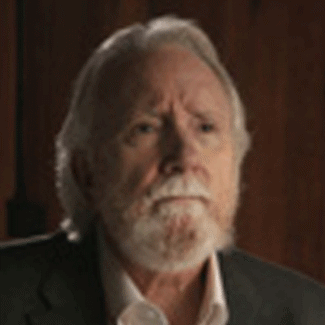by Norm Stamper
February 12, 2015
NOTICE: THIS WORK MAY BE PROTECTED BY COPYRIGHT
YOU ARE REQUIRED TO READ THE COPYRIGHT NOTICE AT THIS LINK BEFORE YOU READ THE FOLLOWING WORK, THAT IS AVAILABLE SOLELY FOR PRIVATE STUDY, SCHOLARSHIP OR RESEARCH PURSUANT TO 17 U.S.C. SECTION 107 AND 108. IN THE EVENT THAT THE LIBRARY DETERMINES THAT UNLAWFUL COPYING OF THIS WORK HAS OCCURRED, THE LIBRARY HAS THE RIGHT TO BLOCK THE I.P. ADDRESS AT WHICH THE UNLAWFUL COPYING APPEARED TO HAVE OCCURRED. THANK YOU FOR RESPECTING THE RIGHTS OF COPYRIGHT OWNERS.

When did today's police officers come to resemble infantrymen in the U.S. military? One former police chief gives insight into reversing the militarization trend. It's time for police to go back to being the heart of community and protecting the people they serve.
You’re in the kitchen. It’s a Saturday morning, still dark outside. Your partner, three-year-old son, and the family dog are all sound asleep at the back of the house. You’ve put the coffee pot on, are making sandwiches—a trip to the lake is planned, your son’s first fishing trip.
Without warning, the pre-dawn quiet is shattered as your front door flies off its hinges, followed by back-to-back explosions and blinding light. Your local police department calling, decked out in cammies, ballistic helmets, and full-body armor, brandishing M4 and M16 rifles.
“Knife!” shouts a cop. “Drop the knife! Drop the knife!” roar his nine fellow officers, each pointing a rifle or a pistol at your chest. The knife in question? A standard, dullbladed utensil you’d been using to slather mustard and mayo on the sandwiches.
You drop the knife.
“Hands behind your head!” belts out the uniformed chorus.
You slap your hands behind your head. As you’re being shoved to the floor, your partner rushes from the bedroom, screaming your name, demanding to know what is happening. Your son follows, wailing hysterically.
Finally comes Boomer, the family’s gentle seven-year-old Golden Retriever, bounding down the hall, voicing his own concern about the invasion. With a Glock semiautomatic, one of the cops silences Boomer: a .40 caliber shot to the head, another to the chest.
To say the SWAT (Special Weapons and Tactics) raid was the most astonishing, traumatic experience of your life is an understatement. Nor was it comforting to learn, once the gun and grenade smoke had settled, that the cops had hit the wrong house. (Slumbering across town, occupants of the “right” house, including a suspected low-level, nonviolent drug offender, were shortly after awakened by the same occupying force.)
As Radley Balko points out in his superb book, Rise of the Warrior Cop: The Militarization of America’s Police Forces, SWAT incidents of the type fictionalized above are proliferating at a frightening pace. In the ’70s, the nation’s roughly 18,000 municipal, county, and state police forces conducted a few hundred such operations a year. By the ’80s the number had grown to approximately 3,000. And in 2005, the last year of collected data, there were more than 50,000 SWAT operations. Today’s count is surely much higher.
The police in America belong to the people, not the other way around.
Balko’s book offers a depressingly abundant supply of all-too-real examples of city and county police officers shooting innocent citizens, getting shot themselves, dispatching beloved family pets, doing major damage to private dwellings, shredding the Constitution, souring relations between police and community, and scarring families for life.
Like the family of Bounkham Phonesavanh. After their home in Wisconsin burned down, the Phonesavanhs moved in temporarily with relatives outside Atlanta. On May 28, 2014, Habersham County Sheriff’s deputies hit the house in a drug raid, battering down the door and tossing in a stun grenade—which landed in “Baby Bou Bou’s” crib. The beautiful 19-month-old child’s face and body were severely burned, his nose blown off in the blast. (Habersham County announced in November that it will not pay the baby’s medical bills, a sum of $1 million and counting.)
How is it that so many of today’s police officers have come to resemble—in appearance, weaponry, and tactics—infantrymen in the U.S. military? A retired army combat sergeant, recently returned from Afghanistan, was interviewed on CNN during the protests in Ferguson, Missouri. He was shown footage of a St. Louis County police officer sitting high atop an MRAP (mine-resistant, ambush-protected vehicle) and pointing a sniper rifle at the crowd. The soldier was astonished and appalled. “This shouldn’t be happening in America,” he said.
The first SWAT team was fielded by Chief Daryl Gates of the Los Angeles Police Department in 1967 (though some say the term originated in Philadelphia in 1964). The first high-profile SWAT operation was against armed and barricaded Black Panthers who had decided to shoot it out with LAPD officers executing a search warrant. Highly publicized SWAT operations in 1974 against the Symbionese Liberation Army and again in 1997 in the “North Hollywood Shootout” (in which two heavily armed and armored bank robbers held LAPD officers at bay for 45 minutes) solidified the popular image of SWAT, and spurred police agencies across the country to adopt the concept.
At the heart of community policing is a demonstrable commitment to a problem-solving partnership between the police department and the people it serves.
There is a time and place for military-style tactics, carried out by police officers who do, in fact, look more like soldiers than cops. Think active shooter situations, or armed and dangerous suspects who’ve taken hostages and barricaded themselves. Think service of warrants accompanied by a reasonable suspicion that the suspects are armed and poised to do violence. Think terrorists.
But it is the routinization of police militarism that ought to concern us all. America’s police departments—aided and abetted by the federal government’s “1033” program, which allocates to local law enforcement military surplus, including armored vehicles, weapons, even aircraft—have gradually morphed from images of “Officer Friendly,” neighborhood-oriented cops to those of war zone occupiers.
Balko’s book and the ACLU’s first-rate new report, “War Comes Home: The Excessive Militarization of American Policing,” offer irrefutable evidence of the trend; both publications ought to be required reading for all Americans who value both freedom and safe neighborhoods.
But how to reverse the militarization trend? As Seattle’s police chief during the World Trade Organization’s 1999 “Battle in Seattle,” and acutely aware of my own unwise reliance on militarized tactics, I realize just how difficult the task will be. But that should not stop us. Here are five steps that can help us turn things around.
1. Residents of cities across the country must rise up and reclaim their police departments.
The police in America belong to the people, not the other way around. An organized, mobilized citizenry is essential to the kind of structural and cultural reforms necessary for reasoned, responsible, and responsive policing.
2. Sustained social and political pressure for demilitarization is essential.
Mayors, city council members, sheriffs, and police chiefs should be elected or selected, in significant measure, on the basis of their dedication to authentic “community policing.” At the heart of community policing is a demonstrable commitment to a problem-solving partnership between the police department and the people it serves. Citizen-police partners must work together to identify, analyze, and solve crime, traffic, and other neighborhood problems—including the nature and quality of the relationship itself. Indeed, police officers and their “civilian” partners must act in unified fashion on agency policies and procedures, program development, and crisis management. No more unilateral decisions about what’s “best for the community.”
3. Local political jurisdictions must implement independent citizen oversight of police practices.
Currently, no single model works flawlessly, and many flounder. But successful approaches in the future will incorporate investigative authority, including subpoena powers, for oversight bodies. Professionalism, competence, and cooperation between police management and labor are essential. It won’t happen by Tuesday of next week. But the hard, thorny work must begin, urgently.
4. It is vital that all law enforcement agencies, in conjunction with their communities, set and enforce rigorous standards for the selection, training, and systematic retraining of SWAT officers and their leaders.
Also crucial: a similarly demanding definition of what justifies a SWAT mission. Emphatically not part of that definition is the use of chemical agents on nonviolent, nonthreatening protesters or the conspicuous presence of military weaponry (including sniper rifles, as seen in Ferguson) at political protests.
It is the people of America…who can bring an end to those horrifying pre-dawn raids and to the specter of a military-like occupation
5. End the drug war.
Eighty percent of all SWAT raids are in service of search or arrest warrants, the vast majority of them aimed at low-level, nonviolent drug offenders. Indeed, it was in the early prosecution of the drug war that we sowed the seeds of police militarization. Certainly, in the aftermath of 9/11 we witnessed a dramatic expansion of police militarization (as well as a deeply troubling attack on our civil liberties). But it has been the “War on Drugs,” with its reliance on the thoroughly bankrupt policy of prohibition, that has done such terrible damage to individuals, families, and neighborhoods, and to the community-police relationship. Ending the drug war, replacing prohibition with a regulatory model, will do much to demilitarize our local PDs. The federal government can and must play a significant role in setting and enforcing national guidelines to end excessive police militarization. But it is the people of America—organized, mobilized, and motivated—who can bring an end to those horrifying pre-dawn raids and to the specter of a military-like occupation of U.S. neighborhoods.
Norm Stamper wrote this article for Together, With Earth, the Spring 2015 issue of YES! Magazine. Norm is a 34-year veteran police officer who retired as Seattle’s chief of police in 2000. He is currently a speaker for Law Enforcement Against Prohibition (CopsSayLegalizeDrugs.com). He is the author of Breaking Rank: A Top Cop’s Exposé of the Dark Side of American Policing.

Norm Stamper
Bio: Norm Stamper wrote this article for Together, With Earth, the Spring 2015 issue of YES! Magazine. Norm is a 34-year veteran police officer who retired as Seattle’s chief of police in 2000. He is currently a speaker for Law Enforcement Against Prohibition (CopsSayLegalizeDrugs.com). He is the author of Breaking Rank: A Top Cop’s Exposé of the Dark Side of American Policing.
